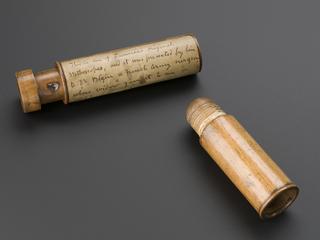

Jobert de Lamballe's vaginal speculum for vesico-vaginal fistula, ivory tri-valved barrel with introducer and chequered ebony handle, by Charriere, from the collection of Charriere, Collin and Gentile, circa 1855
A vaginal speculum examines inside the vagina. It helps medical diagnosis and can also assist treating that area of the body. This example was invented by French surgeon Antoine Joseph Jobert de Lamballe (1799-1867). It is specifically designed for treating vesico-vaginal fistulas. This is a hole that develops between the bladder and the vaginal wall. It often forms as a result of disease, difficult childbirth or other injury.
The condition can be treated with an operation known as a ‘Jobert’s operation’. Jobert designed this instrument. The operation uses a form of skin graft to close the passageway. The ivory speculum has a tri-valved barrel with introducer and chequered ebony handle. It was made by French instrument maker Charriere.
Details
- Category:
- Clinical Diagnosis
- Collection:
- Sir Henry Wellcome's Museum Collection
- Object Number:
- A606231
- Measurements:
-
overall: 100 mm x 256 mm x 45 mm, 45 mm, .23kg
- type:
- vaginal speculum
- credit:
- Drouot




